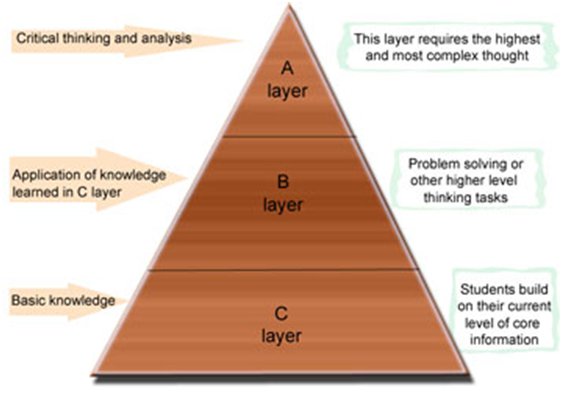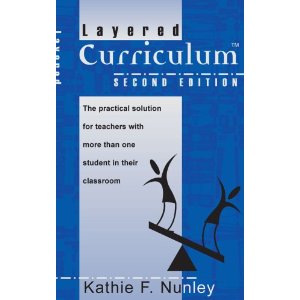As you may have read elsewhere or heard me speak about in person, Dr. Kathie Nunley’s Layered Curriculum® without a doubt saved my teaching career. The shortest workshop I’ve ever seen on Layered Curriculum is three-hours and most often it is taught as either a full day, two day, or multi-day “academy” so trying to explain it completely in a blog post may not do it justice. However, here it goes.
What is Layered Curriculum?
Layered Curriculum is essentially a method of differentiating your classroom to fit the wide range of learning styles and mixed ability levels a teacher might find there. It can be used at virtually any grade level from pre-school through college and can be adapted to fit virtually any subject being taught (though some are harder than others). Dr. Nunley’s website offers a Layered Curriculum in a Nutshell article which is providing the outline for this article, although I’m offering explanations based on her books, seminars and my own experiences with using it.
Step #1: Student Choice
Layered Curriculum begins with the simple yet revolutionary idea of adding student choice to your already existing classroom format. By giving students a choice of what assignment they will do to meet a given objective, students are given a sense of control over their learning they did not previously perceive. This idea is difficult for many teachers to grasp initially, but ask yourself, “Do I really care how a student demonstrates to me that they’ve learned an objective so long as they have, in fact, learned the objective? The answer may surprise you.
Dr. Kathie Nunley is also accomplished in the field of Brain Research, so her ideas regarding student choice are supported. As she likes to explain, somewhat comically, much of what we see as “disruptive behavior” by our students can better be explained the same way we explain monkey’s throwing feces in the zoo…”captive behavior”. By providing them control (or even the illusion of control) over the manner in which they demonstrate learning, students are automatically more vested in the assignment and the learning process.
Building further upon her research, Dr. Nunley illustrates that by providing choices that meet all learning styles (audio, visual, kinesthetic, etc) a teacher can accommodate a wider range of student needs while providing a sense of empowerment at the same time. She recommends an average of three choices per assignment; however one or two more could potentially be acceptable so long as it’s not overwhelming to the student. The idea is to provide a choice to meet every learning style.
Step #2: Accountability
After providing students with choice, the second step is finding unique ways to hold students accountable for learning. As a teacher, find unique ways to shift the focus from doing the assignment to knowing the objective. Dr. Nunley gives Oral Defense as an example, though it is not an essential component in Layered Curriculum. However, it is effective for this purpose. For example, rather than have students working on vocabulary “Choose one of these three assignments and turn it“ instead have students choose from a given list of assignments and then ask them the vocabulary words orally. Click here to learn more about Oral Defense grading.
This can be marked (or graded) in any manner you wish and often it seems the grading practice is where teachers get hung up. Don’t worry about that initially, that’s a whole other can of worms. Instead, simply adapt the grading to match your current gradebook philosophies. If Oral Defense doesn’t sound like your cup of tea, don’t worry. Consider including self-assessment, peer assessment, or performance rubrics instead. The key is ensure students are learning not just doing material.
Step #3: Provide Higher and More Complex Thinking
Finally, Layered Curriculum is made up of three “Layers” aligned to depth of knowledge (DOK) or the old Bloom’s Taxonomy if you prefer. Taken directly from www.help4teachers.com:
C Layer: Basic knowledge, understanding. The student builds on his/her current level of core information.
B Layer: Application or manipulation of the information learned in the C layer. Problem solving or other higher level thinking tasks can be placed here.
A Layer: Critical Thinking and Analysis. This layer requires the highest and most complex thought. Create leaders, voters.

Traditionally these layers are referred to as the “C-Layer, B-Layer and A-Layer” as that’s the grade they most often represent; however aligning the layers with a letter grade is not an essential component. If you do subscribe to that model, it does provide a unique avenue for objective based grading however (by breaking down C-Layer into Objectives) and allows for schools that still hand out traditional letter grades to ensure those letters mean something. A grade of “C” would mean “basic understanding” while a “B” would mean students are able to apply or manipulate learned material. A grade of “A” would mean students are able to “Think Critically” regarding course content. Grading in this manner however, is again, not required to utilize the Layered Curriculum method.
It’s important to ensure that students progress through the Layers in order, and that students are expected to attempt all layers.
The Unit Sheet: Bringing It All Together
All of this information is laid out neatly and concisely on a Unit Sheet provided to students. The Unit Sheet outlines important grading details (however a teacher sees fit to assess), important dates (such as deadlines or tests), the objectives and assignment choices to be learned in C-Layer as well as the assignment choices for B-Layer and A-Layer. Feel free to This email address is being protected from spambots. You need JavaScript enabled to view it. " style="border: 0px; font-style: inherit; font-family: inherit; vertical-align: baseline; color: rgb(18, 130, 196); ">email me if you’d like to see Unit Sheets I’ve used in my own classroom or check out the Layered Curriculum website which has dozens of samples from all grade levels in all content areas.
It’s important that the Unit Sheet provide a clear road map to success for students. It should clearly define expectations and give them a sense of ownership over their learning; however, it’s a constant balancing act. In my experience, a “busy” unit sheet can be overwhelming to a student (particularly an already struggling one). To combat this, I have at times handed out only “Objective Sheets” one at a time until students complete C-Layer, although I admit it’s not ideal it may work better for some classrooms.
Color coding the Unit Sheets can be extremely effective as well, as it helps students keep track of these important pieces of paper while giving each Unit an “identity” so to speak. Students will often refer to past units as “The Blue Unit” for example.
Summary
As I said in the outset, Layered Curriculum is a program that is usually taught in at least a three-hour workshop so if you’re considering giving it a shot and this seems overwhelming, it should. I’d highly recommend at picking up Dr. Kathie Nunley’s book “Layered Curriculum 2nd Edition” or at the very least spend some time perusing through some of the sample Unit Sheets available on her website help4teachers.com or talking to somebody who has done it before, me included. Just remember, like anything else, it takes a bit to get it right so don’t give up on it if your first unit bombs. My first two did before I got it right.


